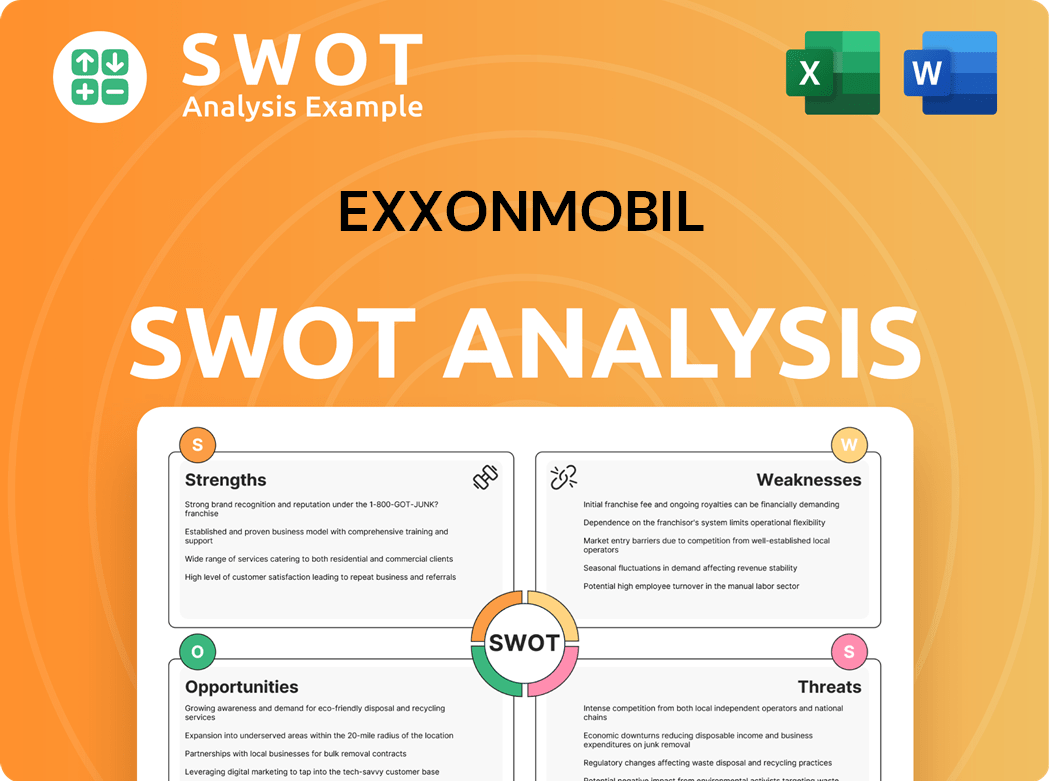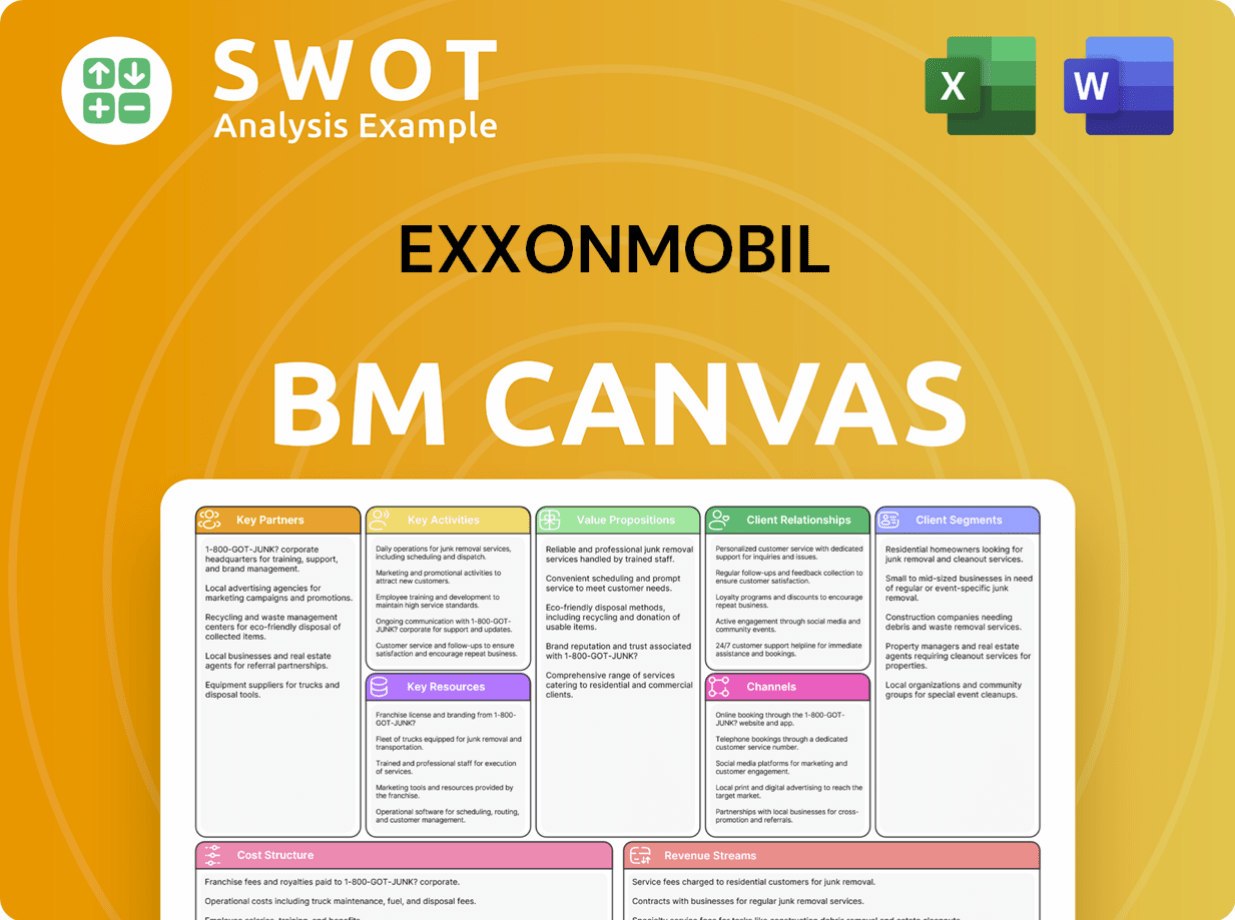ExxonMobil Bundle
Can ExxonMobil Maintain Its Dominance in the Shifting Energy Arena?
ExxonMobil, a titan in the energy sector since its Standard Oil origins, faces a constantly evolving competitive landscape. From its humble beginnings to its current status as a global powerhouse, the company has navigated numerous industry transformations. Understanding the ExxonMobil SWOT Analysis is crucial for grasping its position in the market.

This exploration into ExxonMobil's competitive landscape will dissect its market position, identifying key ExxonMobil competitors and analyzing its strategic advantages. We'll examine the company's response to industry challenges and its strategies for staying competitive, providing a comprehensive ExxonMobil market analysis. Furthermore, we'll delve into the key factors influencing ExxonMobil's competition and its future competitive outlook within the dynamic oil and gas industry.
Where Does ExxonMobil’ Stand in the Current Market?
ExxonMobil maintains a leading position in the oil and gas industry, with a significant presence across the upstream, downstream, and chemical sectors. In 2024, the company demonstrated robust financial performance, reporting earnings of $33.7 billion and generating $55.0 billion in cash flow from operations. This strong financial health is supported by its integrated business model, which includes exploration, production, manufacturing, and marketing, providing resilience against volatile commodity prices.
The company's core operations involve the exploration, production, and sale of crude oil, natural gas, fuels, lubricants, and chemical products worldwide. ExxonMobil's value proposition lies in its scale, integrated operations, and technological expertise, enabling it to efficiently extract and refine resources. The company's global footprint and diversified portfolio help it manage risks and capitalize on market opportunities.
ExxonMobil's strategic focus includes significant production in high-growth regions like the Permian Basin in the US and Guyana. Its net production in 2024 reached its highest level in over a decade, averaging 4.3 million oil-equivalent barrels per day, a 16% increase from the previous year. This growth was driven by record outputs from the Permian Basin and offshore Guyana, highlighting the company's commitment to expanding its production capacity.
ExxonMobil's financial health is robust compared to industry averages. The company's return on capital employed (ROCE) led the industry in 2024 at 12.7%, with a five-year average of 10.8%. Its low net debt-to-capital ratio of 6% and substantial cash flow give it a competitive edge.
ExxonMobil is strategically focused on upstream opportunities, particularly in Guyana, showcasing its dedication to production growth. Despite declines in refining margins and natural gas prices in 2024, the company's strategic cost savings and production growth helped offset these pressures.
ExxonMobil's market position is characterized by its substantial scale and diversified operations. The company's integrated model helps it navigate the volatile ExxonMobil's marketing strategy in the energy sector. This integrated approach allows it to manage risks and capitalize on market opportunities effectively.
Key competitive advantages include its integrated business model, global presence, and technological expertise. These factors enable ExxonMobil to efficiently extract and refine resources. The company's focus on high-growth regions and strategic cost savings further enhance its competitive edge.
The ExxonMobil competitive landscape is influenced by factors such as oil prices, geopolitical events, and technological advancements. ExxonMobil competitors include other major integrated oil and gas companies. The company's strategic initiatives and financial performance are key to its continued success.
- The company's integrated model provides resilience against market volatility.
- Strategic cost savings and production growth from advantaged assets help offset market pressures.
- ExxonMobil's focus on upstream opportunities, particularly in Guyana, showcases its dedication to production growth.
- The company's strong financial health, with a leading ROCE and low debt, gives it a competitive edge.
ExxonMobil SWOT Analysis
- Complete SWOT Breakdown
- Fully Customizable
- Editable in Excel & Word
- Professional Formatting
- Investor-Ready Format

Who Are the Main Competitors Challenging ExxonMobil?
The ExxonMobil competitive landscape is shaped by a complex interplay of global energy dynamics. The company faces competition from both established and emerging players in the oil and gas industry, as well as the growing renewable energy sector. Understanding these competitors and their strategies is crucial for ExxonMobil's strategic analysis and future success.
ExxonMobil's market analysis reveals a landscape where market share, technological advancements, and diversification efforts are key determinants of competitiveness. The company's ability to adapt to changing market conditions, including the energy transition, will significantly influence its position relative to its rivals. This analysis is essential for investors and industry watchers alike.
ExxonMobil's main rivals include a mix of international and national oil companies, each with unique strengths and strategies. These competitors challenge ExxonMobil across various fronts, from production costs and technological innovation to brand recognition and expansion of distribution networks. The competitive environment is constantly evolving, influenced by mergers, acquisitions, and the growing emphasis on sustainable energy sources.
Chevron is a major integrated energy company that often competes directly with ExxonMobil in key oil and gas basins, such as the Permian. In 2023, Chevron reported revenues of approximately $198.9 billion.
Shell is a global energy and petrochemical company with a strong presence in LNG and a growing portfolio in renewable energy. Shell's revenue for 2023 was around $264.8 billion.
BP is another integrated energy major that is actively diversifying its portfolio towards lower-carbon energy solutions. BP's total revenue for 2023 was approximately $200.9 billion.
TotalEnergies is a broad energy company with operations spanning oil and gas, LNG, renewables, and electricity. TotalEnergies generated revenues of around $238.1 billion in 2023.
Saudi Aramco, a national oil company, poses significant competition due to its vast reserves and often lower production costs. In 2023, Aramco's net income was approximately $121.3 billion.
Companies focused solely on sustainable energy sources are increasingly disrupting the traditional oil and gas landscape. The growth in renewable energy capacity is a key factor influencing the ExxonMobil competitive landscape.
Several factors influence ExxonMobil's competition and its position in the global oil market. These include price competition, technological innovation, brand recognition, and the expansion of distribution networks. The company's response to industry challenges, such as the energy transition, will be crucial.
- Price Competition: Fluctuations in oil prices significantly impact profitability and market share.
- Technological Innovation: Advancements in exploration, production, and refining technologies are critical for cost efficiency.
- Brand Recognition: Strong brand reputation helps in attracting customers and maintaining market share.
- Diversification: The shift towards renewable energy sources creates new competitive dynamics.
ExxonMobil PESTLE Analysis
- Covers All 6 PESTLE Categories
- No Research Needed – Save Hours of Work
- Built by Experts, Trusted by Consultants
- Instant Download, Ready to Use
- 100% Editable, Fully Customizable

What Gives ExxonMobil a Competitive Edge Over Its Rivals?
ExxonMobil’s competitive advantages are rooted in its integrated business model, vast scale, technological prowess, and financial strength. This integrated approach, spanning upstream, downstream, and chemical segments, provides resilience and diversifies revenue streams, which helps the company to navigate the volatility inherent in the oil and gas industry. Understanding the Growth Strategy of ExxonMobil is crucial for assessing its competitive position.
Proprietary technologies and continuous investment in research and development are core components of ExxonMobil's strategy. The company's advancements in drilling, extraction, and petrochemical processes enhance efficiency and maintain a competitive edge. Its substantial financial strength, demonstrated by significant cash flow and a low debt-to-capital ratio, allows it to fund large-scale projects and return value to shareholders.
Brand equity and a strong reputation for reliability and operational excellence also contribute to its competitive standing. Furthermore, ExxonMobil has achieved significant structural cost savings, reaching $12.1 billion cumulatively since 2019, which has more than offset inflation and supported growth, a level of savings that surpasses many competitors. These advantages have evolved over time, with the company consistently leveraging them in its strategic partnerships, product development, and market positioning.
ExxonMobil's integrated model, encompassing exploration, production, refining, and chemicals, provides a significant competitive edge. This integration allows the company to manage risks and optimize operations across various segments. The diversified revenue streams help mitigate the impact of fluctuations in any single sector, enhancing overall financial stability.
ExxonMobil invests heavily in research and development, leading to advancements in drilling, extraction, and petrochemical processes. Innovations like 4-mile horizontal laterals and cube drilling improve efficiency and resource recovery. These technological advancements are crucial for maintaining a competitive edge in the energy sector.
ExxonMobil's robust financial health is a key competitive advantage. In 2024, the company generated $55.0 billion in cash flow from operations and $34.4 billion in free cash flow. This financial strength enables significant investments in high-growth regions and substantial returns to shareholders. A low net debt-to-capital ratio of 6% further underscores its financial flexibility.
ExxonMobil benefits from a strong brand reputation and a history of operational excellence. This reputation for reliability and efficiency enhances its competitive standing. The company's focus on cost savings, with $12.1 billion in cumulative savings since 2019, further supports its growth and market position.
ExxonMobil's competitive advantages are multifaceted, enabling it to maintain a leading position in the oil and gas industry. These advantages include an integrated business model, technological innovation, and financial strength. These factors collectively contribute to the company's resilience and ability to outperform competitors.
- Integrated Operations: Provides diversified revenue streams and risk mitigation.
- Technological Leadership: Drives operational efficiency and resource recovery.
- Financial Robustness: Supports large-scale projects and shareholder returns.
- Brand Reputation: Enhances reliability and operational excellence.
ExxonMobil Business Model Canvas
- Complete 9-Block Business Model Canvas
- Effortlessly Communicate Your Business Strategy
- Investor-Ready BMC Format
- 100% Editable and Customizable
- Clear and Structured Layout

What Industry Trends Are Reshaping ExxonMobil’s Competitive Landscape?
The ExxonMobil competitive landscape is significantly influenced by the evolving energy sector competition and global shifts towards sustainability. The company faces challenges from the energy transition, including increasing environmental regulations and the rise of renewable energy sources. However, it also has opportunities in low-carbon solutions and growing demand for natural gas.
ExxonMobil's strategic analysis reveals a focus on balancing its traditional oil and gas operations with investments in new energy ventures. The company aims to maintain a strong financial position while adapting to future market demands. Its competitive environment analysis shows a commitment to operational efficiency and strategic capital allocation to capitalize on growth prospects.
The oil and gas industry is undergoing a transformation driven by the energy transition. This includes a shift towards cleaner energy sources and increasing environmental regulations. The global demand for LNG, particularly in Asia, is also a key trend.
Key challenges include declining demand for fossil fuels, stricter environmental regulations, and geopolitical risks. Volatility in commodity prices and the need to navigate ESG issues also pose significant hurdles. The company faces competition from both traditional rivals and new entrants in the renewable energy sector.
ExxonMobil has opportunities in low-carbon solutions such as carbon capture and storage, hydrogen, and lithium production. The rising demand for LNG, particularly in Asia, also offers growth prospects. Technological advancements and operational efficiencies in exploration and production provide further opportunities.
The company plans to invest up to $30 billion in low-carbon solutions between 2025 and 2030. It aims to deliver $18 billion in cumulative structural cost savings by the end of 2030. Capital expenditures are expected to be between $27 billion to $29 billion in 2025.
ExxonMobil's future competitive outlook involves balancing its traditional oil and gas operations with strategic investments in new energy ventures. The company is focusing on high-return, low-cost-of-supply investments, particularly in advantaged assets like the Permian and Guyana. It aims to maintain resilience and capitalize on future growth opportunities.
- ExxonMobil is actively investing in low-carbon solutions, with plans to spend up to $30 billion on such opportunities between 2025 and 2030.
- The company is targeting $18 billion in cumulative structural cost savings through the end of 2030 versus 2019.
- Capital expenditures are projected to be between $27 billion and $29 billion in 2025.
- The company's strategy includes increasing oil and gas output while investing in low-carbon projects to generate significant earnings and cash flow beyond 2030.
ExxonMobil Porter's Five Forces Analysis
- Covers All 5 Competitive Forces in Detail
- Structured for Consultants, Students, and Founders
- 100% Editable in Microsoft Word & Excel
- Instant Digital Download – Use Immediately
- Compatible with Mac & PC – Fully Unlocked

Related Blogs
- What are Mission Vision & Core Values of ExxonMobil Company?
- What is Growth Strategy and Future Prospects of ExxonMobil Company?
- How Does ExxonMobil Company Work?
- What is Sales and Marketing Strategy of ExxonMobil Company?
- What is Brief History of ExxonMobil Company?
- Who Owns ExxonMobil Company?
- What is Customer Demographics and Target Market of ExxonMobil Company?
Disclaimer
All information, articles, and product details provided on this website are for general informational and educational purposes only. We do not claim any ownership over, nor do we intend to infringe upon, any trademarks, copyrights, logos, brand names, or other intellectual property mentioned or depicted on this site. Such intellectual property remains the property of its respective owners, and any references here are made solely for identification or informational purposes, without implying any affiliation, endorsement, or partnership.
We make no representations or warranties, express or implied, regarding the accuracy, completeness, or suitability of any content or products presented. Nothing on this website should be construed as legal, tax, investment, financial, medical, or other professional advice. In addition, no part of this site—including articles or product references—constitutes a solicitation, recommendation, endorsement, advertisement, or offer to buy or sell any securities, franchises, or other financial instruments, particularly in jurisdictions where such activity would be unlawful.
All content is of a general nature and may not address the specific circumstances of any individual or entity. It is not a substitute for professional advice or services. Any actions you take based on the information provided here are strictly at your own risk. You accept full responsibility for any decisions or outcomes arising from your use of this website and agree to release us from any liability in connection with your use of, or reliance upon, the content or products found herein.